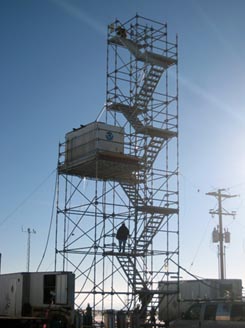
The 2014 Study focused on the ways snow chemistry and aerosol chemistry contribute to the formation of ozone. The study looked at quantifying the contribution of nitrous acid (HONO) and formaldehyde (HCHO) to the chemical reactions responsible for ozone formation. Prior studies in the Basin showed that the radical chemistry that drives ozone production is dominated by HONO and formaldehyde. HONO and formaldehyde are unconventional sources for ozone formation compared to the conventional sources (ozone photolysis) in typical summer urban ozone episodes.
- 2014 Uinta Basin Winter Ozone Study Final Report (13 MB)
- Executive Summary (102 KB)
- Uinta Basin Ozone Study 2014 Fact Sheet (126 KB)
Nitrous Acid (HONO)
Results from UBOS 2013 showed that the primary chemical drivers of winter ozone formation in the Uinta Basin differ greatly from summer ozone formation in urban areas, but left unanswered a key question about the importance of a particular radical source, nitrous acid (HONO).
Key Finding
Measurements made during UBOS 2014 confirmed the unique nature of winter ozone formation mechanisms. By comparing results from five different HONO measurement techniques and making HONO measurements over a wider range of elevations within the polluted atmospheric boundary layer, researchers showed that HONO does not appear to be a major source of radicals during the winter episodes.
Nitrogen Oxide (NOx) Controls
Reducing uncertainties in the radical source chemistry will allow the Division of Air Quality to recommend control strategies with greater confidence. Preliminary modeling indicated that Basin ozone air chemistry will respond to volatile organic compound (VOC) controls. In 2014, scientists also looked at whether HONO would respond to NOx controls.
Key Finding
New “box model” simulations of ozone formation chemistry based on data collected at the Horsepool study site confirmed earlier analyses indicating that ozone formation at this location is sensitive to VOC reductions (i.e., VOC reductions would result in ozone reductions). These results also suggest that NOx reductions, either by themselves or in conjunction with VOC reductions, would lead to ozone reductions at Horse Pool. While providing an important reference point, these box model results do not take into account spatial variations in emissions and the mixing of emissions from different sources, and thus they do not provide a sufficiently-robust assessment of the expected impact of basin-wide VOC or NOx emission reductions on ozone levels to allow formulation of a comprehensive regulatory control strategy. Nevertheless, this result provides support for ongoing VOC reduction measures and is an important contribution to the overall “weight of evidence” guiding the control strategy design.
Formaldehyde (HCHO)
Other key research included an evaluation of oil and gas field sources of fugitive carbonyl emissions, especially formaldehyde, which has been shown to be important in ozone formation in the Basin. Accurate knowledge of formaldehyde sources is critical for development of cost-effective mitigation strategies.
Key Finding
Results from the 2014 measurements confirmed that formaldehyde and other aldehydes are the dominant radical sources. These compounds are both directly released from various emission sources and form in the atmosphere from directly emitted VOCs such as those contained in oil and raw natural gas. Aromatic VOCs, including toluene and xylene, while less abundant than other VOC species in the Basin, are also particularly important sources of radicals.
Recommendations and Path Forward
Participants in the 2014 study proposed the following recommendations and path forward:
- Compare radical sources in areas where oil production dominates with locations where natural gas production dominates. Measurements taken during the 2012 – 2014 studies were collected at Horsepool, where natural gas production dominates. Additional measurements taken in the western basin where oil production dominates would help characterize the influence of oil production sources on ozone episodes.
- Improve current emission measurements and other emission inventory activities. UBOS study results have shown that current emission inventories contain biases that must be corrected. Close collaboration between groups involved in these efforts will be key.
- Conduct additional model development and application work to support emission reduction efforts
Funding Partners
Funding partners include the National Oceanic and Atmospheric Administration, Utah State University, the Department of Environmental Quality, the Uintah Impact Mitigation Special Service District, the Bureau of Land Management, and the Western Energy Alliance.
Research Partners
Research partners include the National Oceanic and Atmospheric Administration, Utah State University, Department of Environmental Quality, University of Utah University of California Los Angeles (UCLA), University of Houston, University of Toronto, Environment Canada, University of Calgary, and University of Washington.

